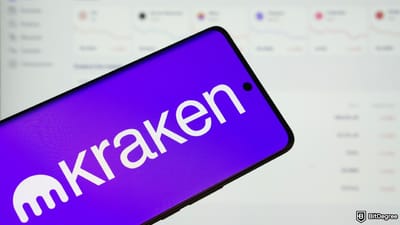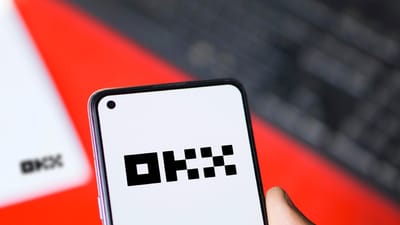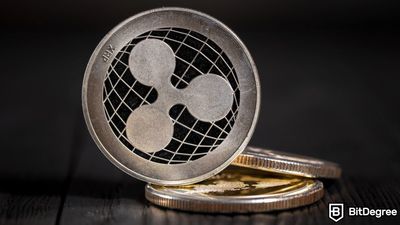Key Takeaways
- KuCoin staking lets you earn passive income by locking assets through flexible or fixed products, paying daily rewards and showing clear yields and positions in KuCoin Earn;
- You can stake ETH via ksETH for liquid staking with protocol-driven rewards and a variable on-chain redemption wait;
- Compared with rivals like Binance and Bybit, KuCoin focuses on tying staking to loyalty perks and other Earn products so you can layer yields and cost savings.
Stop overpaying - start transferring money with Ogvio. Sign up, invite friends & grab Rewards now! 🎁
Let me guess - you’re here because you’re a massive HODLer and want to earn more without risking your potential gains. Well, you’ve definitely come to the right place, because I’ll tell you exactly how to do that with KuCoin staking.
Staking stands out as a popular strategy for putting your crypto to work, allowing you to grow your holdings with minimal risk, and there are many well-known platforms that offer it to their customers, such as Binance or Bybit. However, KuCoin is also worth mentioning for its excellent interest rates, rewards hub, and solid number of crypto listings.
So, let’s dive into this KuCoin passive income feature by learning exactly what it is and how it works.

Did you know?
Subscribe - We publish new crypto explainer videos every week!
What is FUD in Crypto? (Fear, Uncertainty & Doubt Explained)


Table of Contents
What Is KuCoin Staking?
In its simplest form, KuCoin staking is a way to earn passive income by locking up your assets on the platform. So instead of letting your crypto just sit in your wallet, you actually put it to work and get paid for it.
Latest Deal Active Right Now:You might wonder, why would an exchange pay me simply for keeping my coins there? Well, because they need it, just like the traditional banking system. When you deposit money in a bank, the bank uses it to issue loans and pay you interest in return. Staking works in a similar way: your crypto helps support and secure the blockchain, and you earn rewards for making that possible.
Staking crypto on KuCoin is actually just one part of the massive KuCoin Earn ecosystem. In other words, the platform doesn’t stop at staking - it offers a whole bunch of other potential earning opportunities too, like Dual Investment, Shark Fin, and various savings products. This alignment with the network’s security makes staking a core method of earning sustainable, blockchain-native yields.
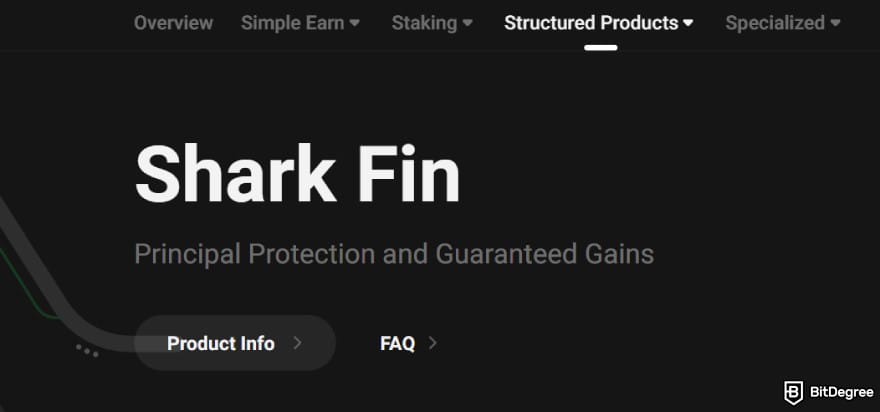
In addition to its wide variety of earning opportunities, staking on KuCoin also stands out with its security features, offering tools like 2FA authentication, anti-phishing codes, and even passkey login options that make it significantly harder for anyone to break into your account.
What that means in practice is simple: since your KuCoin account is much tougher to compromise, your staked assets are also safer by extension. You don’t have to constantly worry that someone might hijack your login and drain your portfolio overnight.
📚 Read More: Is KuCoin Safe?
Navigating KuCoin Earn is also straightforward. The dashboard clearly displays your active staking positions, upcoming rewards, and even estimates your daily yields. It’s a convenient way to keep track of multiple earning strategies in one place, without hopping between different wallets or spreadsheets.
How Does Staking Work on KuCoin
When you try to understand how does staking work on KuCoin, it might seem like everything is just "stake your coins and earn rewards", but there’s actually a bit more going on under the hood. KuCoin basically offers two types of staking experiences, both designed to make things super easy for you, even if the mechanics behind them are quite different.
There are over 40 assets that you can use on KuCoin staking, which is quite a high number compared to other exchanges that offer similar services.
First, there’s what you could call "on-chain staking". For many proof-of-stake tokens like ATOM, DOT, or XTZ, KuCoin uses your funds to participate directly in these blockchains’ staking processes.
That means your assets are actually delegated to real validator nodes on the network, helping validate transactions and maintain the security and decentralization of those blockchains. In return, staking rewards are generated straight from the protocol itself - these are authentic on-chain staking yields, not just platform-based interest.

However, instead of making you go through the technical hassle of setting up a validator or locking up your tokens for weeks or months, KuCoin wraps this whole process into what they call flexible staking.
Here’s where it gets clever: KuCoin still does the on-chain staking behind the scenes, but you get all the benefits through an easy-to-use, flexible product. This means you can typically redeem your tokens whenever you want, without being stuck in long lock-up periods.
Flexible products can still have waiting periods. To be more specific, KCS flexible staking has a 3-day redemption period.
Of course, if you decide to exit early, your accrued rewards might be adjusted - but overall, it’s designed to be far more user-friendly than traditional staking setups.
Then there’s another category, sometimes also called "soft staking", where KuCoin manages everything entirely on their side, without necessarily tying your tokens to on-chain validators at all times.
A good example of this is KCS staking, which isn’t about helping to secure a blockchain through proof-of-stake at all, but rather earning daily rewards directly from KuCoin’s own revenue pool. I’ll dive deeper into how KCS staking works a bit later, since it’s a unique setup that deserves its own spotlight.

Another critical point is that KuCoin typically pays staking rewards daily. This means users begin seeing tangible returns almost immediately after the brief initial settlement period, often beginning on the second or third day after subscription. Regular daily payouts enable effective compounding and provide transparency into how much one is earning.
Now, let’s talk about what makes ETH 2.0 staking and KCS staking so special.
KuCoin Staking Methods
Here’s how KuCoin turns that idea into practice: its staking methods fall into two lanes - protocol-driven staking that delegates to validators, and platform-managed options that prioritize liquidity and simplicity. Understanding the trade-offs between flexibility, lockups, yields, and payout cadence will frame the rest of this chapter, including the two flagship paths you’ll likely use most: ETH staking and KCS staking.
Staking ETH On KuCoin
Staking ETH on KuCoin is actually super straightforward and comes without the usual headache of needing 32 ETH to run a validator.
Thanks to Ethereum’s transition to a proof-of-stake (PoS) system, KuCoin users can now jump into ETH staking and start earning rewards without having to worry about setting up a validator or locking up a huge amount of ETH.
Since there is no minimum entry requirement,[1] you can start staking with however much ETH you have on hand. That applies to other assets as well, which makes staking crypto on KuCoin very approachable. You can start with just a handful of tokens, making it easy to test the waters or gradually build up your position. You also don’t need to know a thing about running validator software or the technical side of it.
When you stake through KuCoin Earn, you receive ksETH in a 1:1 ratio, which serves as your exclusive proof-of-stake token, allowing you to enjoy both liquidity and staking rewards at the same time.
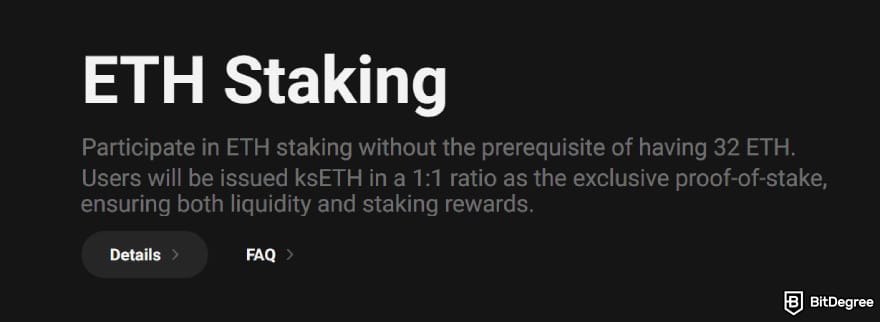
When you’re ready to swap back, you can simply go to the redemption page and convert your ksETH to ETH at a 1:1 rate. However, there’s a waiting period tied to Ethereum’s on-chain redemption process, which, as of writing, is 5 days, but this can change depending on network conditions. KuCoin adjusts accordingly, so it always matches the current state of the Ethereum network.
Rewards from ETH staking are distributed daily. After deducting the operating costs for validator servers, KuCoin pays out the remaining staking rewards based on your ksETH holdings. These rewards usually show up in your Funding Account the following day (T+1), and you can easily keep track of everything from the Redemptions page.
Of course, like any staking, this isn’t completely risk-free. Your returns might be lower than expected due to things like slashing penalties, validator instability, or broader network issues.
Slashing penalties refer to a portion of staked assets being forfeited when a validator misbehaves or fails to follow network rules, serving as a security mechanism for the blockchain.
Plus, if the Ethereum ecosystem doesn’t move forward as planned, there could also be some opportunity costs. Still, for most users, staking ETH on KuCoin offers a super convenient way to grow your holdings and be part of the PoS future, without having to be a technical expert or millionaire.
📚 Read More: Ethereum Staking
KCS Staking & Loyalty Program
KCS is the native token of KuCoin, and through KCS Staking 2.0, you now have a flexible way to earn daily staking rewards. This basically upgrades what was previously known as the "KuCoin Bonus" into a more structured staking product. You can easily subscribe to these products via KuCoin Earn and start generating returns without locking yourself into complicated staking protocols.[2]
Once you subscribe to a KCS staking product, your rewards are calculated daily based on the total amount you’ve staked and the on-chain yield rates. Yield calculation starts the next day (T+1), and your earnings get credited to your Funding Account the day after that (T+2) around 10:00 UTC. Plus, with these staking products, you’re actually enjoying better rewards both from KuCoin’s own revenue distribution and from on-chain yields.
There are different types of KCS staking products available:
- Flexible-term products can be subscribed to and redeemed at any time, giving you total freedom.
- Fixed-term products (like 30-day or 60-day) lock your KCS until maturity. If you don’t redeem at the end, they’ll just continue to earn fixed-term yields automatically.
Here’s a quick look at the current options:
Term | Reference APR | Redemption Period |
|---|---|---|
Flexible | 1.76% | 3 days |
30 days | 1.85% | 0 days (instant upon maturity) |
60 days | 1.88% |
Table: KuCoin's KCS staking products and APRs
Keep in mind that these APRs are only estimates, and they can fluctuate daily, so it’s best to check KuCoin from time to time for the latest information.
On top of the straightforward yield, staking KCS not only unlocks loyalty perks but also helps you grow your holdings through KuCoin Earn interest. Your tier, from K1 all the way up to K4, is determined by how much of your overall portfolio you’ve allocated to staked KCS.
As you move up these levels, you’ll benefit from progressively better perks: substantial trading fee discounts that can exceed 20%, boosted cashback rates when using the KuCoin Card, and preferential access or multipliers in special token sales like GemPool or Spotlight events. Higher tiers also come with VIP-style advantages, such as lower withdrawal fees and even dedicated customer support.

As you can see, staking KCS is more than just picking up an extra 1–2% APR. It’s a strategy that systematically reduces your costs across trading and transactions, improves your participation in new project launches, and generally makes every part of using KuCoin more rewarding. This synergy between staking and KuCoin’s broader loyalty ecosystem is a standout feature that most other exchanges simply don’t offer.
And there’s even more convenience baked in: by enabling it in your profile settings, you can use your staked KCS directly to pay for trading fees. This doesn’t switch on by default, so you’ll need to toggle the "Pay Fees with KCS" option yourself - but once active, it ensures your staked assets are always working double duty by generating yield while also cutting down on your trading costs.
📚 Read More: KuCoin Fees
Combining KuCoin Staking and Other KuCoin Earn Products
As I’ve already pointed out, KuCoin Earn isn’t just about staking your crypto and collecting passive income. It’s a much broader ecosystem that lets you mix and match different earning products to either maximize your returns or strategically cut down your costs, depending on what your goals are.
This all becomes even more powerful once you bring KCS loyalty levels into play. By staking KuCoin's native token, you don't just earn a modest staking yield; you actively level up your KuCoin account, unlocking a whole range of perks that can transform your overall strategy. These loyalty tiers typically go from Level 1 (K1) up to Level 4 (K4), and the difference between them isn't minor - it's a serious jump in benefits.
Just take a look at how a few key features scale up as you move from Level 1 to Level 4:
Feature | Level 1 | Level 4 |
|---|---|---|
GemPool Lock-Up Bonus | 5% | 20% |
Transaction Fee Discounts | 20.5% | 22% |
KuCard Rebate | 0.5% | 5.5% |
Withdrawal Fee Rebate | 10% | 40% |
Table: KuCoin's loyalty level bonuses
So, instead of just putting all your funds into a single staking product and waiting, KuCoin’s system actually encourages you to build a layered approach. For example, you could:
- Stake part of your portfolio in KCS to move up the loyalty tiers. This immediately slashes your trading fees, boosts your GemPool and Spotlight allocations, and enhances your overall staking bonuses on other products.
- Lock up some DOT or MATIC in fixed staking, capturing higher APRs thanks to longer commitments.
- Keep a slice of your assets in flexible staking or KuCoin’s lending marketplace, earning daily interest while preserving liquidity for when opportunities pop up.
- Leverage Smart Earn to automatically find the best yield among staking pools, liquidity programs, or promotional offers, without you needing to manually shuffle your assets.
- And finally, use your elevated KCS tier perks to secure better discounts or larger allocations in new token launches through Spotlight or to get bigger bonuses in GemPool events.
But that’s not all. The KuCoin Rewards Hub adds yet another layer to this strategy. KuCoin is constantly running new campaigns and simple task-based promotions where you can earn extra crypto, often paid out in USDT.
These tasks are usually straightforward, like making a small trade, joining a learning quiz, or trying out a specific Earn product. Once you collect these small rewards, you can quickly convert your bonus USDT into any asset you plan to stake, right inside the exchange.
From there, it’s just one more step to stake your new tokens and start earning even more passive income, effectively growing your staking portfolio with almost zero additional spend.
KuCoin Staking VS Other Platforms
Compared with Binance and Bybit, KuCoin’s staking differs in more than headline yields or the number of supported coins. The way each exchange integrates staking into its broader ecosystem ultimately has a bigger impact on the strategies you can use.
KuCoin Staking & Earn | Binance Earn | Bybit Easy Earn | |
|---|---|---|---|
Available coins | Over 40 staking assets | 300+ assets (varies by region) | Over 220 assets |
Staking yields | Typically 1% - 20% APR | 0.06% - 245% (very wide range) | 0.3% - 555% (heavily token dependant) |
Products offered | Flexible & fixed staking | Simple Earn | Flexible & fixed savings |
Security | ✓ Transparent ✓ Regular reports | ✓ Globally licensed | ✓ Proof-of-Reserves ✓ Cold storage & KYC/AML |
Table: KuCoin, Binance, and Bybit staking comparison
Binance clearly wins when it comes to sheer asset variety, and Bybit stands out with its occasional sky-high promo yields on certain tokens.
At the moment of writing, staking USDT on Bybit can reach up to 555% APR. However, such rates are short-term promotional offers with caps and limited eligibility (often new users).
KuCoin, on the other hand, offers something different: its staking is tightly connected to your KCS loyalty level, which doesn’t just boost your staking returns but also cuts down your trading fees and improves your access to token launches like Spotlight or GemPool.
It’s also worth mentioning that KuCoin operates under offshore licenses and isn’t regulated in major markets like the US or EU, though it does publish regular transparency reports and has earned a solid reputation among global users.
In short, if your main goal is chasing the broadest coin selection or the flashiest yields, Binance and Bybit might be more tempting. But if you’re looking to combine staking rewards with loyalty perks and early project access all in one place, KuCoin has carved out a pretty compelling niche.

- Secure and reliable
- Accepts fiat currencies
- Lots of trading options
- Reputable exchange
- Accepts fiat currencies
- Offers various trading options

- Huge trading variety
- Regulation-compliant around the globe
- Fair trading fees
- Beginner-friendly
- A wide array of features
- Vast number of different crypto coins & tokens

- Beginner-friendly
- Secure
- Decent trading and withdrawal fees
- Crypto.com Visa Card
- Automated tools & bots
- Ecosystem synergy with CRO
How to Stake on KuCoin
You already know the essentials and how staking works on KuCoin, so setting it up is actually super straightforward. Here’s a quick step-by-step on how to do it:
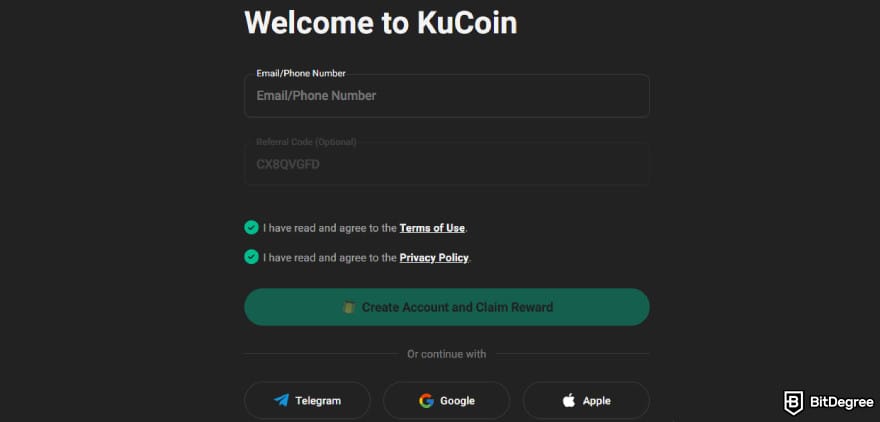
![KuCoin staking: one red arrow pointing to the [Earn] button, the other at [Staking]. KuCoin staking: one red arrow pointing to the [Earn] button, the other at [Staking].](https://assets.bitdegree.org/images/kucoin-staking-step-2.jpg)

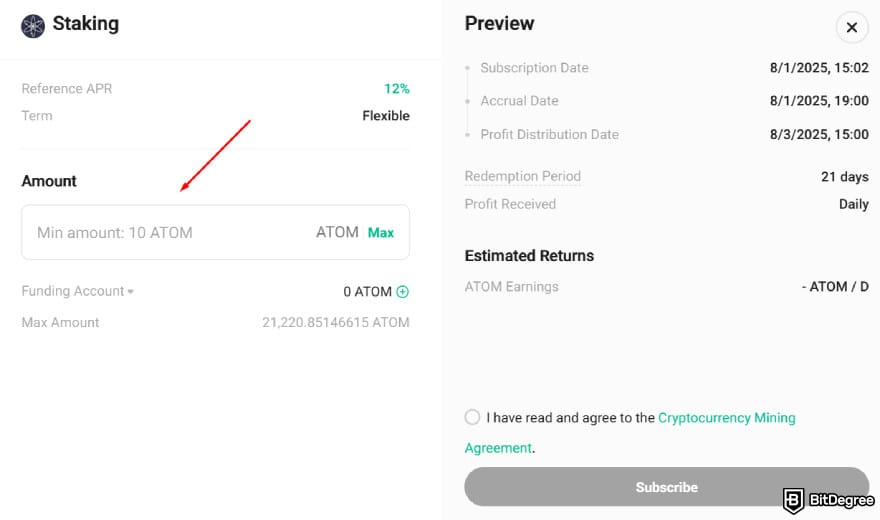
And that’s it. You’re all set - your crypto is now staked and will start earning rewards according to the plan you selected.
Conclusions
When it comes to passive income, KuCoin staking offers more than just straightforward yields. By tying staking into loyalty levels, fee discounts, and exclusive launch perks, it turns a simple investment into a broader strategy. That’s what makes it such an interesting option for anyone looking to grow their crypto portfolio.
By combining staking with lending, Smart Earn, and Rewards Hub campaigns, you can maximize your KuCoin Earn interest and build a layered approach to passive income. This allows you to stack multiple income streams or cost-saving benefits at once, without jumping between platforms.
The content published on this website is not aimed to give any kind of financial, investment, trading, or any other form of advice. BitDegree.org does not endorse or suggest you to buy, sell or hold any kind of cryptocurrency. Before making financial investment decisions, do consult your financial advisor.
Scientific References
1. Takei Y., Shudo K.: 'Effective Ethereum Staking in Cryptocurrency Exchanges';
2. Lehmann M., Held A., Krysa F., Prevost E., Schinerl F., Vogelauer R.: 'Staking Your Crypto: What Are the Stakes?'.



